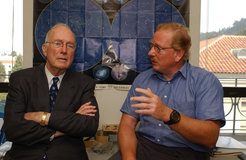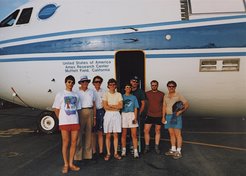Prof. Charles Townes, MPE external scientific member, dies at 99

Charles Townes discussing physics with Reinhard Genzel.
“The passing away of Professor Charles Townes marks the end of an era,” said astrophysicist Reinhard Genzel, MPE director and professor of physics at UC Berkeley. “He was one of the most important experimental physicists of the last century. To those who knew him as colleagues or students, he was a role model, a wonderful mentor and a deeply admired person. His strength was his curiosity and his unshakable optimism, based on his deep Christian spirituality.”
Townes was 35 in the spring of 1951 when, seated on a park bench among blooming azaleas in Washington, D.C., he was struck by the solution to a longstanding problem, how to create a pure beam of short-wavelength, high-frequency light. That revelation – not much different from a religious revelation, Townes believed – eventually led to the first laser, a now ubiquitous device common in science, medicine, telecommunications and entertainment. Townes shared the 1964 Nobel Prize in Physics with two Russians, Aleksandr M. Prokhorov and Nicolai G. Basov, who independently came up with the idea for a maser.
Born July 28, 1915, in Greenville, S.C., Townes attended Furman University and graduated summa cum laude in 1935 with a BS in physics and a BA in modern languages. He completed an MA in physics at Duke University in 1936 and moved to Caltech, from which he obtained his Ph.D. in 1939. His thesis involved isotope separation and nuclear spins.
He then joined the technical staff at Bell Labs in New Jersey, where he stayed through the war designing radar bombing systems. After that he began applying his expertise in microwaves to spectroscopy, which he foresaw as providing powerful new tools for probing the structure of atoms and molecules and for controlling light. He continued this work at Columbia University after accepting a faculty position there in 1948, where he built the maser with graduate student James Gordon and post-doctoral researcher Herbert Zeiger. In 1961, after a brief tenure at the Institute for Defense Analyses, he was appointed provost and professor at MIT. He continued his research on quantum electronics and moved into the new field of infrared astronomy. In 1967 he was named a UC Professor-at-large based on the UC Berkeley campus.
Here, Townes soon learned of plans by young professor William “Jack” Welch to build a short-wavelength radio telescope, and offered some of his startup funds to build a maser amplifier and microwave spectrometer so the telescope could be used to search for evidence of complex molecules, like ammonia, in space. Told by many, including the astronomy department chairman, that such molecules could not possibly survive in space, Welch and Townes persisted and in 1968 proved them wrong. They were the first to discover three-atom combinations – ammonia and water vapour – near the centre of the Milky Way galaxy. Others soon discovered even more complex molecules, providing evidence for a host of chemical reactions taking place in young and dying stars and giving credence to the idea that molecules from space could have seeded Earth with the building blocks of life.
In a UC Berkeley lab staffed mostly by students, Townes moved on again to pioneer the field of infrared astronomy, essentially looking at sources of heat in outer space, and precision infrared spectroscopy. He developed a novel infrared detector incorporating a precision CO2 laser, which made it easier to study this wavelength of light without contamination from hot sources all around us. His infrared studies of the centre of the galaxy with Reinhard Genzel revealed in 1985 swirling gas clouds that could only be orbiting a massive object, presumably a black hole. That discovery was later confirmed by Genzel and others.

In 1987, Townes became external scientific member at the Max Planck Institute for Extraterrestrial Physics and closely collaborated with the infrared team here. The main common project (1986-1995) was the Far-Infrared Fabry-Perot Interferometer (or FIFI for short), an instrument for the Kuiper Airborne Observatory (KAO). This instrument was designed, built and operated jointly to investigate star formation and other astrophysical processes in our Milky Way and neighbouring galaxies. Parts of the FIFI technology were developed further towards MPE's successful PACS instrument on board the Herschel Space Observatory.
Townes was a member of the National Academy of Sciences, National Inventors Hall of Fame, South Carolina Hall of Fame and Engineering and Science Hall of Fame. He received honorary degrees from 25 colleges and universities and numerous honours, including the National Medal of Science, National Academy of Sciences’ Comstock Prize and the John J. Carty Medal, Rumford Premium of the American Academy of Arts and Sciences, Stuart Ballentine Medal of the Franklin Institute (twice), the C.E.K. Mees Medal of the Optical Society of America, the Medal of Honour of the Institute of Electrical and Electronics Engineers, Plyler Prize of the American Physical Society, NASA’s Distinguished Public Service Medal, Thomas Young Medal and Prize of the Institute of Physics and the Physical Society (England), Wilhelm Exner Award (Austria) and the 1979 Niels Bohr International Gold Medal. In 2002, he received the Karl Schwarzschild Medal of the German Astronomische Gesellschaft.
He also was a member and former president of the American Physical Society, a member of the American Academy of Arts and Sciences and the National Academy of Engineering, and a foreign member of the Royal Society and the Russian Academy of Sciences.













